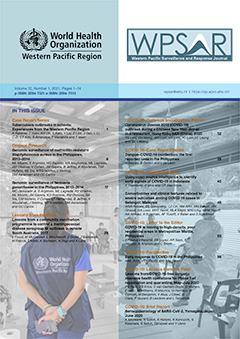Genomic surveillance of Neisseria gonorrhoeae in the Philippines, 2013–2014
DOI:
https://doi.org/10.5365/wpsar.2020.11.1.005Abstract
Antimicrobial-resistant Neisseria gonorrhoeae is a major threat to public health and is of particular concern in the Western Pacific Region, where the incidence of gonorrhoea is high. The Antimicrobial Resistance Surveillance Program (ARSP) has been capturing information on resistant gonorrhoea since 1996, but genomic epidemiology studies on this pathogen are lacking in the Philippines.
We sequenced the whole genomes of 21 N. gonorrhoeae isolates collected in 2013–2014 by ARSP. The multilocus sequence type, multiantigen sequence type, presence of determinants of antimicrobial resistance and relatedness among the isolates were all derived from the sequence data. The concordance between phenotypic and genotypic resistance was also determined.
Ten of 21 isolates were resistant to penicillin, ciprofloxacin and tetracycline, due mainly to the presence of the blaTEM gene, the S91F mutation in the gyrA gene and the tetM gene, respectively. None of the isolates was resistant to ceftriaxone or cefixime. The concordance between phenotypic and genotypic resistance was 92.38% overall for five antibiotics in four classes. Despite the small number of isolates studied, they were genetically diverse, as shown by the sequence types, the N. gonorrhoeae multiantigen sequence typing types and the tree. Comparison with global genomes placed the Philippine genomes within global lineage A and led to the identification of an international transmission route.
This first genomic survey of N. gonorrhoeae isolates collected by ARSP will be used to contextualize prospective surveillance. It highlights the importance of genomic surveillance in the Western Pacific and other endemic regions for understanding the spread of drug-resistant gonorrhoea worldwide.
References
Wi T, Lahra MM, Ndowa F, Bala M, Dillon JR, Ramon-Pardo P, et al. Antimicrobial resistance in Neisseria gonorrhoeae: Global surveillance and a call for international collaborative action. PLoS Med. 2017;14(7):e1002344.
Wi TEC, Saniel OP, Ramos ER, MacNeil J, Neilsen G. RTI/STI Prevalence in Selected Sites in the Philippines. 2002.
WHO Western Pacific Region. External Review of the National Health Sector response to HIV and Sexually Transmitted Infections 2013: Republic of the Philippines. 2015.
Unemo M, Shafer WM. Antimicrobial resistance in Neisseria gonorrhoeae in the 21st century: past, evolution, and future. Clin Microbiol Rev. 2014;27(3):587-613.
Fifer H, Natarajan U, Jones L, Alexander S, Hughes G, Golparian D, et al. Failure of Dual Antimicrobial Therapy in Treatment of Gonorrhea. N Engl J Med. 2016;374(25):2504-6.
George CRR, Enriquez RP, Gatus BJ, Whiley DM, Lo YR, Ishikawa N, et al. Systematic review and survey of Neisseria gonorrhoeae ceftriaxone and azithromycin susceptibility data in the Asia Pacific, 2011 to 2016. PLoS One. 2019;14(4):e0213312.
Martin IM, Ison CA, Aanensen DM, Fenton KA, Spratt BG. Rapid sequence-based identification of gonococcal transmission clusters in a large metropolitan area. J Infect Dis. 2004;189(8):1497-505.
Jolley KA, Maiden MC. BIGSdb: Scalable analysis of bacterial genome variation at the population level. BMC Bioinformatics. 2010;11:595.
Unemo M, Golparian D, Nicholas R, Ohnishi M, Gallay A, Sednaoui P. High-level cefixime- and ceftriaxone-resistant Neisseria gonorrhoeae in France: novel penA mosaic allele in a successful international clone causes treatment failure. Antimicrob Agents Chemother. 2012;56(3):1273-80.
Clinical and Laboratory Standards Institute. M100-S26 Performance Standards for Antimicrobial Susceptibility Testing. 26th Edition. 2016.
Argimon S, Masim MA, Gayeta JM, Lagrada ML, Macaranas PK, Cohen V, et al. See and Sequence: Integrating Whole-Genome Sequencing Within the National Antimicrobial Resistance Surveillance Program in the Philippines. BioRxiv. 2019.
Page AJ, De Silva N, Hunt M, Quail MA, Parkhill J, Harris SR, et al. Robust high-throughput prokaryote de novo assembly and improvement pipeline for Illumina data. Microb Genom. 2016;2(8):e000083.
Page AJ, Taylor B, Delaney AJ, Soares J, Seemann T, Keane JA, et al. SNP-sites: rapid efficient extraction of SNPs from multi-FASTA alignments. Microb Genom. 2016;2(4):e000056.
Stamatakis A. RAxML version 8: a tool for phylogenetic analysis and post-analysis of large phylogenies. Bioinformatics. 2014;30(9):1312-3.
Harris SR, Cole MJ, Spiteri G, Sanchez-Buso L, Golparian D, Jacobsson S, et al. Public health surveillance of multidrug-resistant clones of Neisseria gonorrhoeae in Europe: a genomic survey. Lancet Infect Dis. 2018;18(7):758-68.
Sanchez-Buso L, Golparian D, Corander J, Grad YH, Ohnishi M, Flemming R, et al. The impact of antimicrobials on gonococcal evolution. Nat Microbiol. 2019;4(11):1941-50.
Bailey AL, Potter RF, Wallace MA, Johnson C, Dantas G, Burnham CA. Genotypic and Phenotypic Characterization of Antimicrobial Resistance in Neisseria gonorrhoeae: a Cross-Sectional Study of Isolates Recovered from Routine Urine Cultures in a High-Incidence Setting. mSphere. 2019;4(4).
Mortimer TD, Grad YH. Applications of genomics to slow the spread of multidrug-resistant Neisseria gonorrhoeae. Ann N Y Acad Sci. 2019;1435(1):93-109.
Bennett JS, Jolley KA, Sparling PF, Saunders NJ, Hart CA, Feavers IM, et al. Species status of Neisseria gonorrhoeae: evolutionary and epidemiological inferences from multilocus sequence typing. BMC Biol. 2007;5:35.
Didelot X, Dordel J, Whittles LK, Collins C, Bilek N, Bishop CJ, et al. Genomic Analysis and Comparison of Two Gonorrhea Outbreaks. MBio. 2016;7(3).

